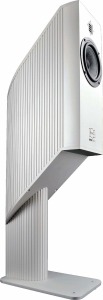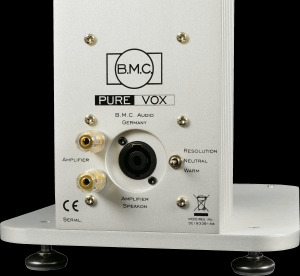Having enjoyed a taste of the BMC Pureline products such as the PureDAC and PureUSB1 Cable, I was primed to accept an invitation from Brian Ackerman of Aaudio Imports, the North American distributor for BMC, to review the PureVOX speaker. He unabashedly made some claims of outstanding performance of this floor standing monitor speaker, and based on the performance of the PureDAC I expected good things.
My expectations were met, beginning with the meticulous packaging I have come to expect from anything sent to me from Aaudio. Though not so large as to require a specialty shipper, the speakers arrived sandwiched between two sheets of plywood atop a pallet and cinched down with tough looking camouflaged straps seemingly strong enough to secure a military Humvee. Nevertheless, the side of one box showed a significant crease. Expecting perhaps some degree of damage, I was pleasantly surprised when I opened the box to find the speaker ensconced in a massively thick sea of molded foam protective material such that it might be dropped from several feet and not register the impact at all. Perhaps the speakers would have survived the trip to my home, but without the palletizing the boxes likely would not have. I have reviewed several products carried by Aaudio Imports, and I cannot recall any that have been damaged in shipping.
I alluded to this speaker as a floor standing monitor to describe its physical nature; it is a smaller two-way speaker with a cabinet of approximate volume to larger monitors, but with an integrated floor stand. The review pair had a dull Blue Titanium coloration clean through; only the spikes were of a different composition, appearing to be of stainless steel. (Per Brian, the spikes were not part of the package. -Pub.) The coloration strikes me as quite pleasant, falling somewhere between garish, bright sports car colors and dull brown or black. When subjected to bright sunlight the speaker glints toward a brighter Safire blue, but when put away from bright light the surface retreats to a near gunmetal hue. If blue is not to your taste you can get the speaker in “BMC Silver”.
The speaker appears to be a balancing act between the rear support column and forward jutting body, which rises funnel-like out of an upward sloping bottom baffle. It is thin, with narrow vertical ribbing reminiscent of corrugated cardboard wrapped about the stand and sides of the speaker. The ribbing yields to a contoured smooth front baffle with the naked drivers on display. At the rear of the speaker stand is found both the expected positive and negative speaker cable posts, as well as a Neutrik connector. Also in this location is a three-way toggle switch to adjust the speaker’s tonality.
For an in-depth discussion of the PureVOX’s design and construction, I direct the reader to BMC’s web page. The reader may also wish to refer to my article on the BMC PureDAC and PureUSB1 Cable, as it discusses how BMC has the capacity to produce a superior product in large numbers, thus lowering the cost of what would be otherwise a more expensive product.
- (Page 1 of 3)
- Next page →




Instead of giving more information about the speakers, you wasted one entire page by “experimenting with turning the speakers around,” something just as dumb as placing a regular front-firing speaker upside-down to see what happens. But I still like the review.
Vdorta,
God’s Peace to you,
So, I take it you won’t be using the omnidirectional placement option. 🙂
I like to give the type of information which might result in a far more enjoyable ownership experience, and I don’t care much if it’s not acceptable to Audiophile sensibilities. Someone who lays out $6K and learns that they have two options for great sound might disagree strongly with your dismissal.
Omnidirectional speakers seem to be one of the most despised, or disrespected
of speaker designs, so I don’t expect much praise for my comments about the PureVOX being
a good faux Omni.
Blessings,
Douglas Schroeder
Doug:
What kind of low frequency response are these speakers capable of? No specs. were given by the company, and not much mentioned in your review, beside your categorizing them somewhere between a bookshelf speaker and the Vapor Audio speakers you mentioned. Please let me know when you get a chance….Thanks for your help!
Doug:
A few questions:
How did the speakers compare to the Sonos speakers?
In terms of the NAS used, how would you compare the sonic attributes of the Buffalo Linkstation 500G model to other models of the Buffalo line?
What is a “Dexa NewClassD Discrete Opamp Upgrade” and what is the break-in period for something like this?
I saw that you have several DACs including inter alia the BMC PureDAC and the Musical Fidelity V90-DAC. I’ve heard both and they are excellent. Given their respective price points, do you think that the BMC is ten times better?
I notice you use no room tweaks. Have you determined that they are in fact a waste of money or do you have aesthetic or other constraints (e.g., wife or partner opprobrium) influencing your decision?
Thank you as always for the excellent review.
Blessings to you,
Scott
Scott,
God’s Peace to you,
I appreciate the complement; thanks for the support! Briefly, here are your answers:
I have not heard Sonos speakers. Did you mean Vapor Audio speakers? The Nimbus White is far superior, as it should be at the price.
I have no experience with other models of the Buffalo NAS products.
Please see my Audio Blast article here at Dagogo “Eastern Electric Minimax DAC Plus – Discrete Opamp Rolling” for further info on that topic.
No, the BMC is not ten times better, and such an arbitrary association is not common in the High End. Products obviously do not scale to several multiple times better as though a direct function of cost. If you seek such a sterile direct relationship in audio components, you will be sorely disappointed.
I have determined through testing that tweaks such as brass bowls, etc. are a waste of time, as they miserably fail my Law of Efficacy, which states that a change must be instant, obvious and of such a performance improvement that it merits the cost. I am not including room tuning devices such as sound panels and diffusers, etc. Typically only cables and components/speakers are capable of such changes. Opamp rolling occurs in the signal path, and as such is inherently more capable than these others, and I do not consider it a tweak but an upgrade. You will need to consult the manufacturer to see whether they discuss a break in period. I do not recall any of the manufacturers I have spoken with discussing a break in period.
Blessings,
Douglas Schroeder
I’m a little confused how Kingsound electrostatic speakers could possibly be omnidirectional. As far as I have ever seen, all electrostatic loudspeakers are dipole in radiation pattern unless enclosed like the JansZen zA2.1
Sincerely,
Greg
Greg,
Gods’ Joy to you,
You caught a mental glitch in my article; on page three I meant to reference the “Kingsound King Tower” speakers, a model which Performance Devices, the North American distributor for Kingsound, decided not to sell. I picked up the demo pair which were shown a couple years at C.E.S. If you wish to see them you likely can by searching online for images by the name of the speaker. I will have the article amended to accurately reflect the proper model.
Kingsound likes to name their speakers using royal titles, so it can be easy to confuse them. However, their sound quality is tremendous.
Thanks for calling this to my attention!
Blessings,
Douglas Schroeder
Hi Doug,
I have the Wells amp, so I am curious have full these speakers sound. In other words, do they give instruments, voices, etc proper body? I don’t have a lot of experience with aluminum speakers, but the ones I have heard sound extremely articulate but somewhat analytical, but not necessarily “warm” for lack of a better word. I guess I err to the warm side in my preference.
Thanks,
Mark
Mark,
The Joy of God to you,
Do you like panel speakers? Do you enjoy not having the sound of a cabinet? If you are usually captivated by warm sounding speakers, like Vandersteen’s line up to the 3’s, then you may not be the right type of person for the PureVOX.
If you are worried about missing the colorations of a speaker with a wooden cabinet, you may need to audition the PureVOX before deciding.
Blessings,
Douglas Schroeder
Hi Doug, hoping you may have a few words of help for me. Closest BMC dealer is a state away, so it won’t be easy for me to hear them. I currently own Wilson Benesch Arcs for a small room, and I don’t find the lack of a wooden box a problem – I love what the carbon fiber cabinet does for the Arcs. The sound completely disconnects from the box, so to speak. My question is specifically about the AMTs on the PureVox…how would you compare its signature to good silk domes like those WB uses, or Proac, or Dynaudio, or even the B&W Diamond tweeter? In terms of etchiness, sweetness, smoothness, sibilance, etc. how does the PureVox AMT implementation stack up specifically vs. nice silk domes? Thank you!
Thank you for a thorough review and it does help boost my interest in this pair.
Being a HT enthusiast myself, may I ask if you would recommend this pair as main speakers in a HT system?
Thanks a million & God bless
Eric, Daniel,
God’s Peace to you,
Sorry, Eric for tardy reply! I find silk dome tweeters to typically be reticent, so the tweeter on the PureVox was more appealing to me. Having heard some strident tweeters I had no sense of the Treble being etched or too bright.
Daniel, If you are looking for a HT pair of mains that give a sense of the gargantuan and unlimited LF, then, no, these won’t do so. But, in a moderately sized HT setup I think they would do very well.
Blessings,
Douglas Schroeder